 |
|
Moderate Hurricanes?
Consider the real possibility that today's technologies
are sufficient to enable us to reduce the ferocity of hurricanes.
|
Calm a hurricane? Maybe we can.
|
End the terror of endless hurricanes.
|
Let's lessen the devastation.
|
|
|
|
|
| 1 |
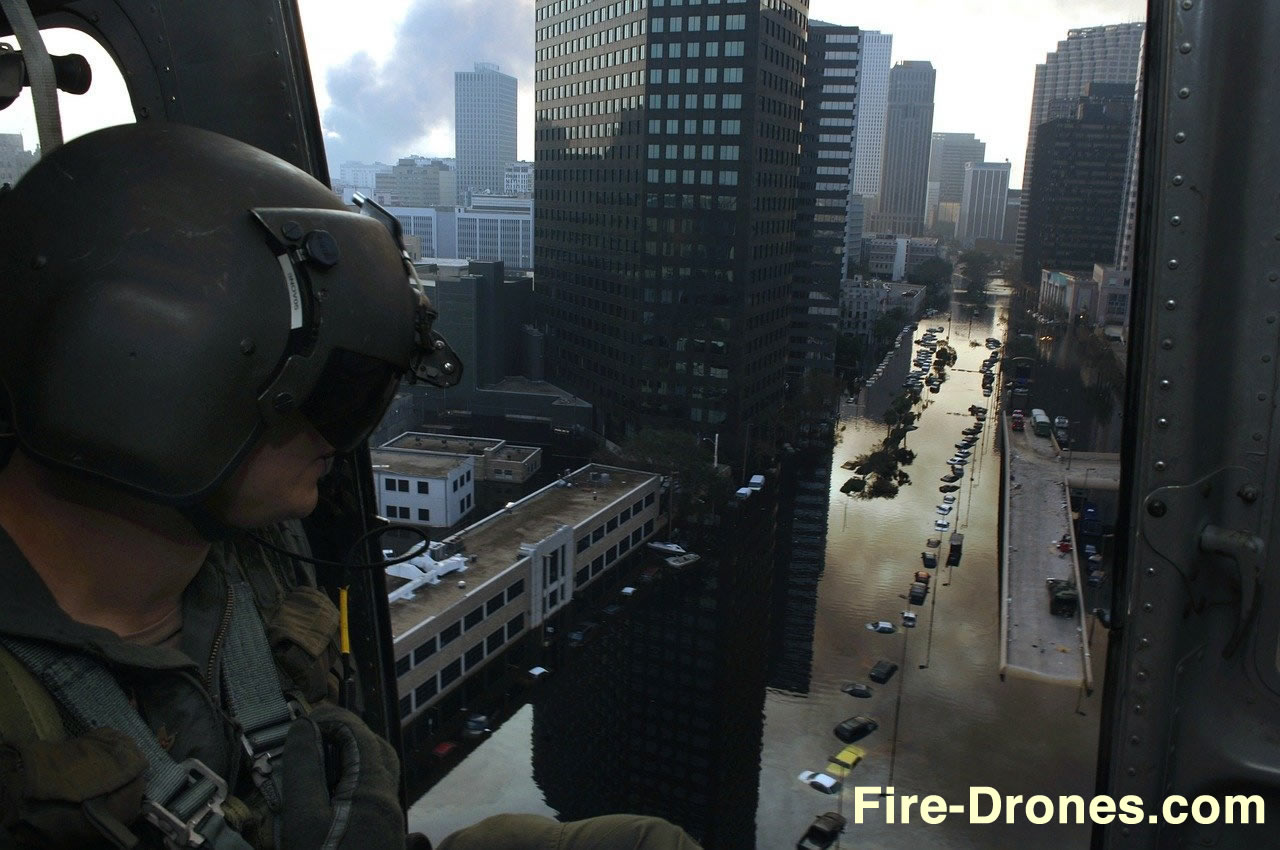
Hurricane Harvey - August, 2017.
"In a five-day period, the storm produced more than 50 inches of rain in the Houston area, flooding
more than 300,000 structures and causing more than $120 billion in damage."
CLICK 2 HOUSTON.COM • Image by David Mark via Pixabay |
|
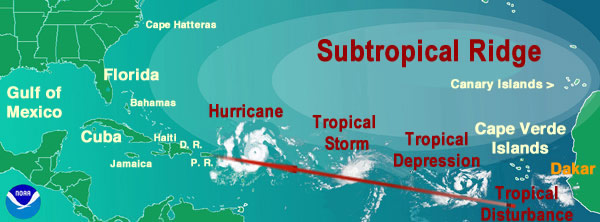
Courtesy US National Oceanic and Atmospheric Administration (NOAA)
Subtropical Ridge, Hurricane, Tropical Storm, Tropical Depression, Tropical Disturbances, The Canary Islands, Cape Verde Islands / Cabo Verde
Dakar Senegal, Cape Hatteras, Florida, Gulf of Mexico, Bahamas, Jamaica, Haiti, the Dominican Republic, Puerto Rico. |
|
|
|
|
We've all been there.. lazy on a hot summer afternoon, on a picnic blanket in a field, or on our beach chair, with our feet in the sand.
Then we notice some clouds rolling in. As they block out the sun, the
air temperature drops—and the
air begins to feel a lot cooler.
What if we employed this principle to let our ingenuity craft sky-borne
panels whose purpose
is to cool
large areas above or below it?
|
|
|
|
 |
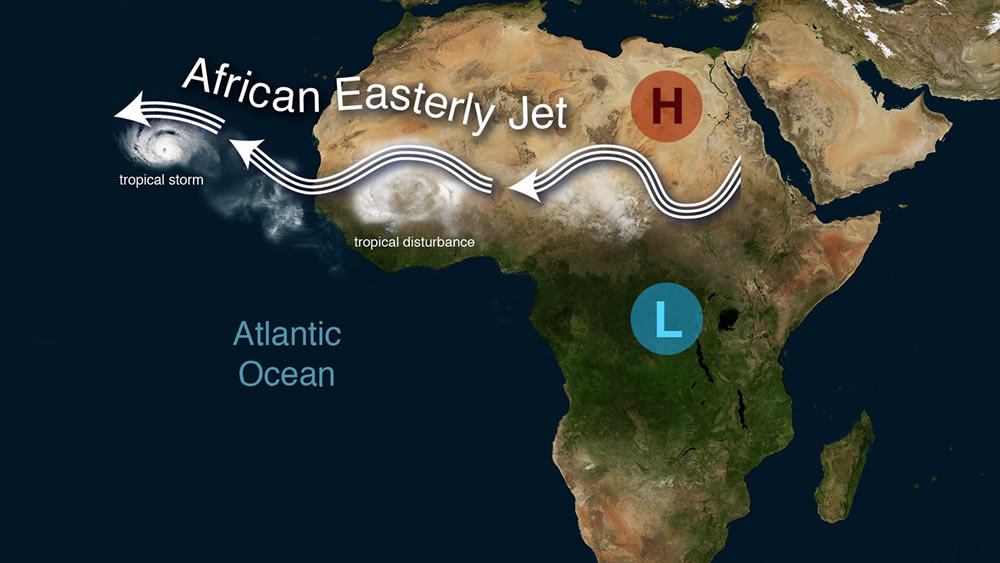
Natalie Renier, WHOI Graphic Services • Translation: African Easterly Jet — tropical storm — tropical disturbance - Atlantic Ocean — H High — L Low
Hurricanes that are born off the west coast of Africa—and then cross the Atlantic to arrive in the Caribbean—begin their journey in one general area: The Cape Verde Islands / Cabo Verde.
But the story actually begins further inland, with hot Saharan desert air in the vicinity of Senegal and The Gambia. That air flows westward, and eventually crosses the land-sea boundary.
Relatively cooler ocean air currents laden with moisture rise up to greet the hot westerly flow, and the African Easterly Jet intensifies. Wind speeds increase, vertical upward drafts become particularly intense, and the entire system begins to spin as one entity. As its journey across the Atlantic gets underway, it is fed by continuously rising warm moisture-packed air and radiant heat from the ocean's surface. Even the Earth's rotation adds energy to the dynamic.
Amazingly, whether or not a hurricane will form right there can be predicted today. SCIENCE ALERT
Armed with precision information, we might then tailor a response to thwart that formation.
The storm goes through its life cycle—some storms morphing quickly, and others more slowly:
Tropical Disturbance > Tropical Depression > Tropical Storm > Tropical Cyclone.
That last stage is more commonly known to many as a Hurricane.
Tropical Disturbance > |
Tropical Depression > |
Tropical Storm > |
Tropical Cyclone |
|
|
|
|
The birth of a hurricane, having only a slight circulation with no closed isobars around an area of low pressure.
Tropical Disturbances commonly exist in the tropical trade winds at any one time and are often accompanied by clouds and precipitation. |
If sustained winds increase to at least 20 knots, a disturbance is upgraded to a Tropical Depression.
Surface wind speeds vary between 20 and 34 knots and a Tropical Depression has at least one closed isobar that accompanies a drop in pressure in the center of the storm. |
If sustained wind speeds increase to at least 35 knots, a Tropical Depression is upgraded to a Tropical Storm.
Surface wind speeds vary between 35 and 64 knots and the storm becomes more organized.
Tropical storms resemble the appearance of hurricanes due to the intensified circulation. |
As surface pressures continue to drop, a tropical storm becomes a Hurricane when sustained wind speeds exceed 64 knots.
A pronounced rotation develops around the central core as spiral rain bands rotate around the eye of the storm.
The heaviest precipitation and strongest winds are associated with the eye wall. |
Image/Text/Data from the University of Illinois WW2010 Project. • Copyright © 1997 by the University of Illinois Board of Trustees
• Please click here to view the original source material: Hurricane Stages of Development |
The brief introduction above is a greatly simplified description for a natural phenomenon that is actually incredibly complex—and about which much scientific research has been devoted.
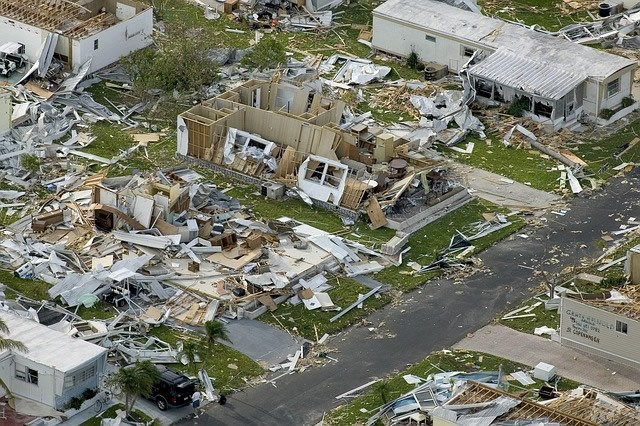
How can SunMirrors in Africa tone down hurricanes in the West Indies?
If you had 500,000 SunMirrors available to you—each one-sixth the area of a football field—
could you position them in various locales, at varying altitudes?
Could your purpose be to manage the energy that is feeding
the nascent hurricane so that you actually tamp down its power?
It need not prevent a hurricane from forming. Its goal is to simply and massively reduce its ferocity.

The West Sudanian Senegalese Savanna
You might position 200,000 SunMirrors inland, in close formation high in the sky, where a hot surge of dry Saharan air is heading for the coast. Those mirrors are positioned over a well-defined volume of heated air, and reflect a high percentage of incoming solar energy back to space, reducing the temperature below.
You then might position 100,000 just off the coast—this time, half of that deployment just 100 meters above the ocean's surface. The initial burst of rising wet sea air spreads laterally and, as importantly, the SunMirror fleet prevents sunlight from reaching the ocean, and raising its mean temperature. The other half would position itself above the storm system, reflecting heat back to space. Visualize this as a "sandwich" that robs the system of its energy from both above and below.
The remaining 200,000 take on two roles:
1) To precede the storm as it crosses the Atlantic on its westward journey to the Caribbean—continuously cooling the ocean below by preventing the sun's energy from warming it, and...
2) To hover over the storm at high altitude deflecting sunlight from energizing it further.
Both modes will vacuum heat away from the weather system, and reduce the storm's power and coherence. This is the same principle as the intervention provided by the 100,000 just off the African coast. The big difference is that the 200,000 SunMirrors cross the Atlantic travelling with the storm, continuously executing their mission to constantly and meaningfully rob that storm of its energy.
SunMirror interventions would shape heat and convection currents to achieve a precious goal:
••• Reducing the destructive potential of the threat barreling westwards. •••
Though we are describing a particular intervention for the sake of visualizing this process, the same principles would apply to any dangerous hurricane formation zone on the planet.
Note that all SunMirrors boast two markedly different skill sets:
1) They can reflect the sun's energy back to space above their surface, and/or...
2) They can shape rising currents below to instead spread laterally, preventing heat from revving up the storm.
These capabilities remove heat from the equation, and they add up to achieve the goal of tamping down a hurricane.
If you could field such a system, someone might say: "Well, that hurricane was pretty destructive." But consider if that event would have been a Category 5 hurricane, but with our intervention became only a Category 2—would that achievement not be worth the effort?
One may balk at the hubris and magnitude of this particular endeavor. But as in many large-scale solutions, it comes down to the individual unit of solar management. If just one prototype could provide positive experimental data regarding efficacy, then there is no rationale to not scale up an effort that can prevent the current massive destruction we submit to, year-in and year out.
Yes, it sounds far-fetched, and might not be possible. But it may be possible. Using the most powerful supercomputers to analyze the variables, and inviting interested and serious scientific teams to consider if this could work—then perhaps we might find that we could tamp down a menacing hurricane just enough to make a meaningful difference.
Hurricanes are becoming stronger—not weaker. Their demoralizing devastation could steer us to evaluate if this design might have real efficacy. The cost of a successful outcome will be dear. But so too are the shocking costs of ever larger, more powerful, and more numerous hurricanes.
|
|
The specifics of what a SunMirror is
capable of,
and how it might operate on the job.
|
A SunMirror is a radically re-designed version of an unmanned airship.
It generates continuous lift by safely employing Hydrogen (H2). It is different than any other airship flying. It doesn't look like the blimps, Zeppelins or dirigibles of the past.
SunMirrors can remain aloft indefinitely.
They sport vast sun-facing top surfaces that are able to produce all the prodigious energy required for safe and swift flight.
They travel at faster speeds than airships due to the coordinated action of thousands of rotors on all surfaces of the vessel. There are no wings, elevators, jet engines, or propellers.
SunMirrors can rise up while parallel with the ground or ocean surface, or assume any needed angle—even upside down.
Hurricanes grow larger, more powerful — and occur with much greater frequency.
They move more slowly over land than before and they are more destructive and deadly. The number of hurricanes spawned compared with previous seasons is shocking. NOAA, THE HILL, NY TIMES Intervening to curtail their fury is a greater imperative with every passing year, in order to save both lives and property.
SunMirrors are Hurricane dampeners.
SunMirrors shape and control developing hurricanes and may be a solution to a major and growing issue confronting our planet.
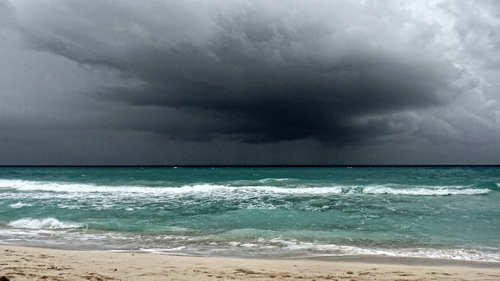
A storm begins its formation 350 miles / 570 kilometers off the coast of Africa in the vicinity of the Cape Verde Islands— a storm which will become a Category 5 hurricane causing massive damage and hundreds of fatalities when it slams into the Caribbean.
SunMirrors will have no effect on large well-formed storms or hurricanes
What will make them effective is being ready to act in known hurricane spawning grounds—when a would-be storm is just forming.
Thousands of SunMirrors go to work when and where needed to stop hurricanes from developing. They are deployed in all the spawning grounds of our planet.
Their goal will be to transform a Hurricane into a Tropical Storm, or at least a lesser category of Hurricane, i.e. Cat 2 instead of Cat 4.
A SunMirror will be lightweight — yet will still boast an
enormous surface area.
SunMirrors are designed to stay aloft indefinitely—and they only return to base for routine maintenance. They reflect the sun's energy to space, and the ocean below cools.
Notice how effective clouds are in bouncing the sun's energy to space. A SunMirror may greatly exceed those numbers. NASA

Earth's Energy Budget • NASA Atmospheric Science Data Center.

Albedo, or the amount of energy reflection from any given surface, is measured on a scale of 0 to 1.0. A black surface might be 0, and most of the Sun's radiant energy would turn to heat. 1.0 is reflectance that almost all the energy falling on a SunMirror will bounce back into the atmosphere and to space.
The ocean has an albedo of 0.06—close to black—and absorbs most of the solar energy falling upon it, warming the top layers of the sea directly below. The Sun's ocean-warming power is generally most prolific at the Equator.
The Sun's rays at midday pass through the least amount of atmosphere, and strike with the greatest intensity—creating fertile ground for continuous storm production.
What is it going to cost to field a worldwide SunMirror armada?
A lot. But, a lot less than the cost of the new breed of monster hurricanes which devastate countries, destroy homes, farms and factories, ruin crops, flood vast areas, kill people—and forever enshrine the caprice of nature as a new fear we live with every day of our lives.
Building out SunMirror fleets will surely be expensive. Economies of scale will lower the costs. Satisfaction with the benefits may quell our financial concerns.
Production of fleets of SunMirrors will take time. With 25 factories around the world, the task can be achieved quickly.
To match the scale of even a small Tropical Disturbance will take years of constant production and introduction of new units. As that SunMirror Task Force grows, they will gradually become more effective over time.
Hurricanes do offer distinct benefits:
• Bacteria control and red tide breakup.
• Redistribution of global heat.
• Replenishment of barrier islands.
• Renewal of inland plant life.
• Spreading plant seeds far and wide.
Those benefits may yet be achieved without also causing major damage when a hurricane is tamped down to just a Tropical Storm.
Cloudy week ahead?
Hundreds of optimized long-life batteries store solar energy generated by a SunMirror's solar cells, and deliver it—powering all the craft's systems at peak efficiency, day or night.
Those solar cells are able to handily power the craft for three weeks before they would need to climb to a cloud-free altitude to recharge.
We may be able to tamp
this
down to be a lot less destructive.
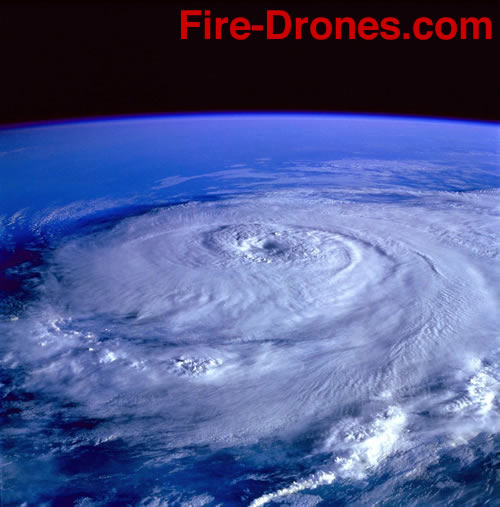 Image by David Mark from Pixabay Image by David Mark from Pixabay |

This graph shows how the average surface temperature of the world’s oceans has changed since 1880. This graph uses the 1971 to 2000 average as a baseline for depicting change. Choosing a different baseline period would not change the shape of the data over time. The shaded band shows the range of uncertainty in the data, based on the number of measurements collected and the precision of the methods used. Data source: NOAA, 2016
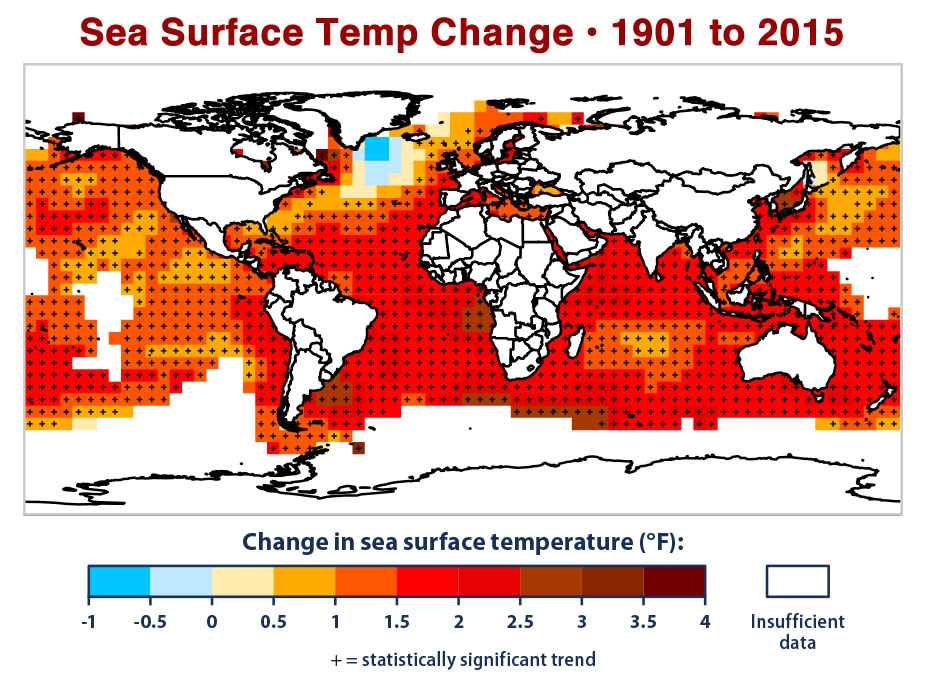
This map shows how average sea surface temperature around the world changed between 1901 and 2015. It is based on a combination of direct measurements and satellite measurements. A black “+” symbol in the middle of a square on the map means the trend shown is statistically significant. White areas did not have enough data to calculate reliable long-term trends. Source: IPCC, 2013; NOAA, 2016
SunMirrors come together to stop the sun’s heat
from reaching the ocean below, and to disperse heat laterally — and therby reduce energizing the growing storm.
They stay in
formation or move apart gently to permit specific amounts of
sunlight through.
Cooling a large ocean area—where upwelling energy is generating storms which eventually become hurricanes—may now be moderated sufficiently to achieve our goal.
Thousands of SunMirrors can all face the sun angled for
maximum reflectiveness.
In unison—much like a great ballet—they slowly rotate through the day as the
sun transits the sky. They shadow the storm across the ocean to mediate its energy. Rainfall will be moderate upon arrival in the Caribbean.
The intense warming that would give birth to a Hurricane is kept in check. The winds which normally would race in to feed the storm are repelled by the descending cooler ocean air.
A portion of the fleet will break off and accompany the storm across the ocean.
Control facilities will continuously tweak all airborne parameters: altitude, speed, angle and coverage density.
Once they've transited the Atlantic, those that require repair will land at purpose-built facilities to perform the work. Upon completion, they will float back to Africa to join the fray once again.
A SunMirror is made from ultra-lite hBN- hexagonal Boron-Nitride. This material is 10 times stronger than steel, but with just 5% of its density. A SunMirror does not carry cargo, humans, or their life-support systems.
New technologies now allow for Hydrogen to be safely utilized in unmanned aerial vehicles.
SunMirrors run on sunlight. They stay aloft with cheap and abundant Hydrogen gas. Helium today is both expensive, and in short supply.
Here's a similar technology in the same vein: SCIENCE NEWS
SunMirrors store non-polluting energy in lightweight batteries for night flight and changing direction. All the free and clean energy they require comes from the inexhaustible Sun.
A SunMirror only reflects sunlight or dissipates rising heated air laterally. It carries no cargo. It might be the lightest of all airships.
Sun Mirrors will require no fossil fuels for their production, management,
mobility, repair or continuous operation in our planet’s skies.

Vitaliia Kalmutska - Project Artist
SunMirrors increase or decrease speed as needed. SunMirrors can float in the sky without moving, like a helicopter. Their operational range is from 150 feet above the ocean to 15,000 feet.
Rotors instantaneously swivel, allowing the craft to precisely alter its angle and stay in conformity with fleet safe-distancing protocols. Climb and descent are controlled by H2 redistribution in their internal container sacs, in concert with the formidable power of cybernetically controlled rotor-rich surfaces.
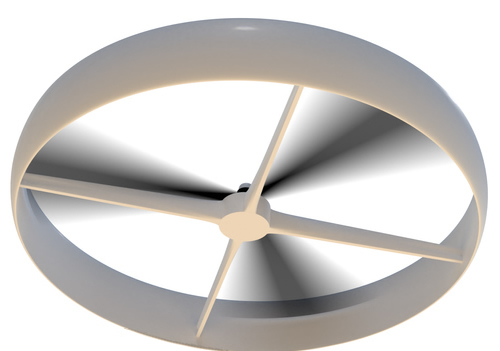
SunMirror propulsion is created by directing thousands of small yet powerful rotors on the craft's edges and surfaces. These same rotors control directional flight by instantaneously changing direction for sure-footed steering.
They will be powered directly by sunlight.
Perhaps 10% of the sky-facing SunMirror's surface may employ MIT solar cells to produce orders of magnitude more energy than conventional solar cells. Solar energy will be stored in efficient and large capacity batteries to power night and cloudy-day flight.
“The power-to-weight ratio is where these new cells come into their
own. With a demonstrated output of 6 watts per gram, they produce an
output some 400 times greater than standard glass-covered solar cells
that generate about 15 watts of power per kilogram on average.” NEW ATLAS
|
|
|
|
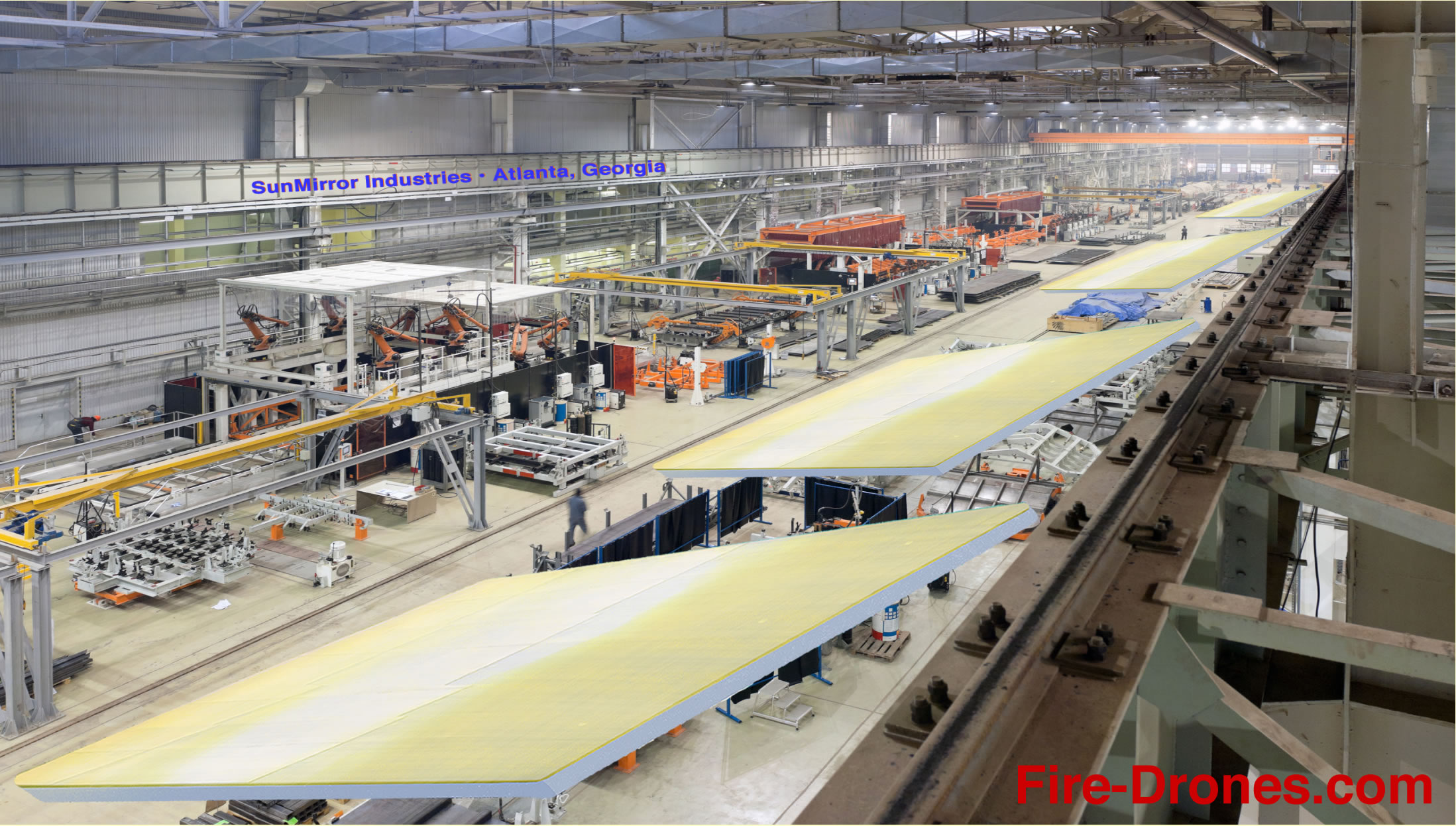
"The Promise of Quiet Reflection." • Vitaliia Kalmutska - Project Artist
25 factories pump out a total of 1,000 SunMirrors
a day:
Jobs created√ Cities saved√ Hurricanes reduced to storms√
|
A pristine Amazon absorbs 2 billion tons of CO2 per year.
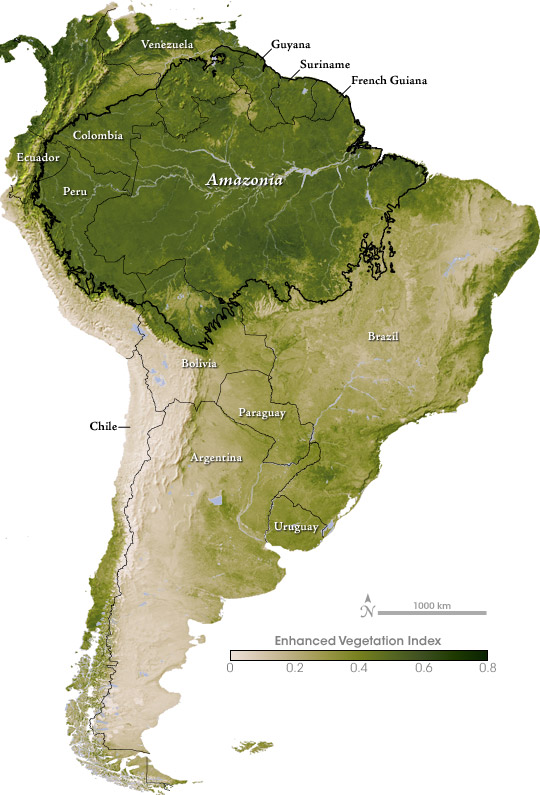
NASA • EARTH OBSERVATORY
If we destroy our vast forest ranges all over the globe, so too will we reduce the amount of atmospheric Oxygen in our sky— Oxygen that we all breathe in.................................... about twenty-two thousand times a day.
If there's just one thing you might wish to share with all of your closest friends today, it's that our actual breathing—the overwhelming vast majority of it—comes from its production in our forests... yeah, the ones full of trees.
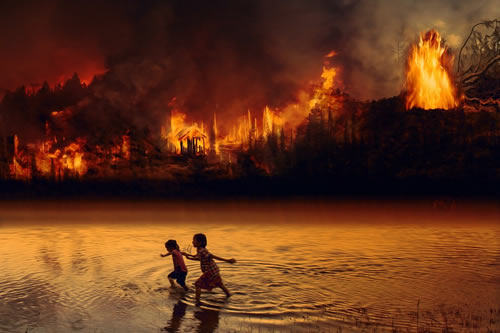 Image by Ria Sopala from Pixabay Image by Ria Sopala from Pixabay
20%
of all greenhouse gas
emissions
are the result
of tropical deforestation. |

|
Fire Drone technology may be essential to preserve the world's forests. The Amazon will need a wildfire safety net as any forested area of our planet will require in the coming years.
Consider three statistics.
• 9% of the Oxygen in our atmosphere is produced by the Amazon.
• 18% of the Amazon has already been destroyed by slash and burn farming.
• 20% of all greenhouse gas emissions are the result of tropical deforestation — a major concern with dire implications for the planet.
ENVIRONMENTAL DEFENSE FUND
The Amazon—for thousands of years a major planetary 'Carbon sink,'—naturally absorbs 2 billion tons of CO2 per year. Tragically, that figure is diminishing with every passing year due to the wanton destruction of its endless rain forests for the purpose of farming.
To make it worse, the burning also adds unprecedented amounts of CO2 into the atmosphere. It is a lose / lose disaster.
"Parts of the Amazon rainforest are now emitting more Carbon Dioxide than they absorb, raising fears of the potentially devastating impact on its fragile ecosystems and a further worsening of the climate crisis, according to a new study." CNN • NATURE • 2021
The Amazon's total area is about two million square miles. By comparison, the lower 48 United States is a little larger than three million square miles.
The Amazon loses 150 acres of rainforest
per minute: 78 million acres, or 122,000 square miles a year—the size of New Mexico.
RAIN TREE
If that rate of deforestation is not curtailed, the Amazon might disappear within 16 years.

Biodiversity and Native Peoples at Risk
"The Amazon rainforest, home to the greatest diversity of animal life on land, has some truly amazing species. Today the activities of humans in the Amazon threaten countless species with extinction." SCIENCEING
The paragraph above is
edited
from the original for clarity and relevance.
"An estimated 1.7 million people belonging to some 375 indigenous groups live within ∼3,344 indigenous territories (ITs) and ∼522 protected natural areas." PNAS
Their inhabited areas are also a potent guardrail preventing deforestation.
Despeciation of the flora and fauna is happening every day. Indigenous peoples face uncertain futures as their world collapses around them. PNAS
The Amazon contains a cornucopia of medicines, with thousands not catalogued, and thousands more yet to be discovered.
NY TIMES
Brazil can be persuaded to change its policies regarding the Amazon. The issue is not only with Brazil though—so too will the other nations with significant portions of their territory in the Amazon have to change.
Failure to change course will have severe consequences for the global climate. The Amazon deserves our efforts. NY TIMES
"The world's tropical forests are rapidly losing their ability to absorb Carbon Dioxide from greenhouse gas emissions, with the Amazon rainforest at risk of turning from Carbon sink to source within 15 years." SCIENCE ALERT
Watch this poignant and powerful CNN investigation into the Amazon's cultural and environmental destruction- taking place as you read this webpage. CNN |
|
|
|
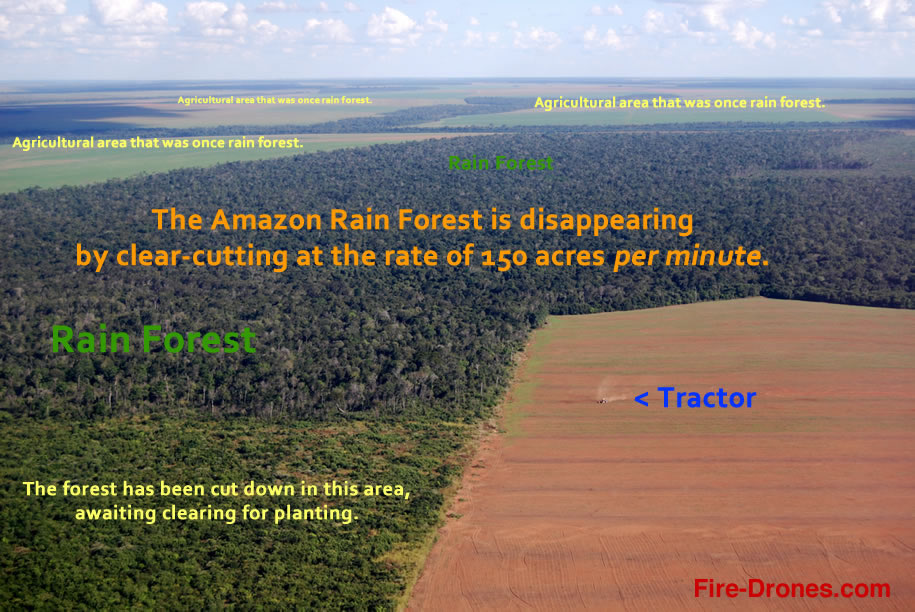
Rain Forest. Agricultural area that was once rain forest. The Amazon Rain Forest is disappearing by clear cutting at the rate of 150 acres per minute.
The forest has been cut down in this area, awaiting clearing for planting. < Tractor. |
|
It's often worse than we predicted. |
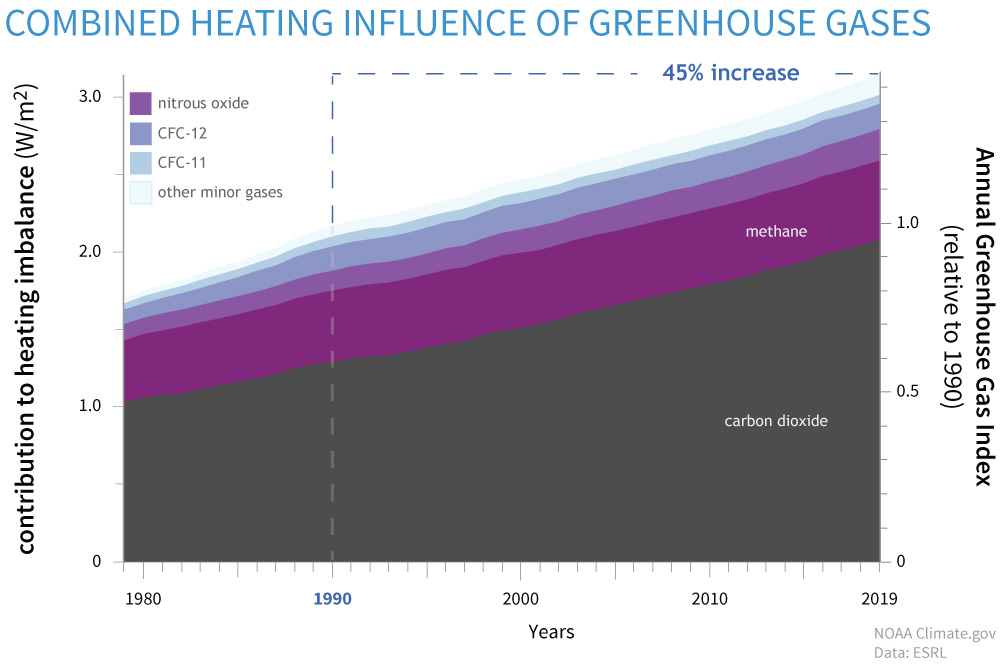
COMBINED HEATING INFLUENCE OF GREENHOUSE GASES
Contribution to heating imbalance. Annual Greenhouse Gas Index
With all of the careful science, no one predicted the Australian firestorm of 2019 nor the catastrophic US West Coast fires of 2020.
The curve for atmospheric warming due to the release of CO2, Methane and the many other greenhouse gases might easily ratchet up faster than we expect or predict in spite of recent reports of a slowing emissions profile.
This could occur with a rapid and likely increase in wildfires—and the destructive power inflicted by the new breed of Megafires.
This will arrive due to the most dangerous viscious cycle you might contemplate: CO2 released into the atmosphere results in more heat which in turn allows for more wildfire ignitions and broader swaths of forest burning with every passing year—and this yearly cycle continues to swell: It is not diminishing.
We might acknowledge that dynamic and take it into account as we methodically face the challenges ahead. It will take bold solutions, such as the rapid fielding of hundreds of thousands of Fire Drones to insure our future.
If we fail at this, we may lose everything.
|
"This graph shows the heating imbalance in watts per square meter relative to the year 1750 caused by all major human-produced greenhouse gases: Carbon Dioxide, Methane, Nitrous Oxide, ChlorofluoroCarbons 11 and 12, and a group of 15 other minor contributors. According to NOAA's Annual Greenhouse Gas Index (right axis) the combined heating influence of all major greenhouse gases have increased by 43% relative to 1990." NOAA
"New NASA-funded research has discovered that Arctic permafrost’s expected gradual thawing and the associated release of greenhouse gases to the atmosphere may actually be sped up by instances of a little known process called abrupt thawing.
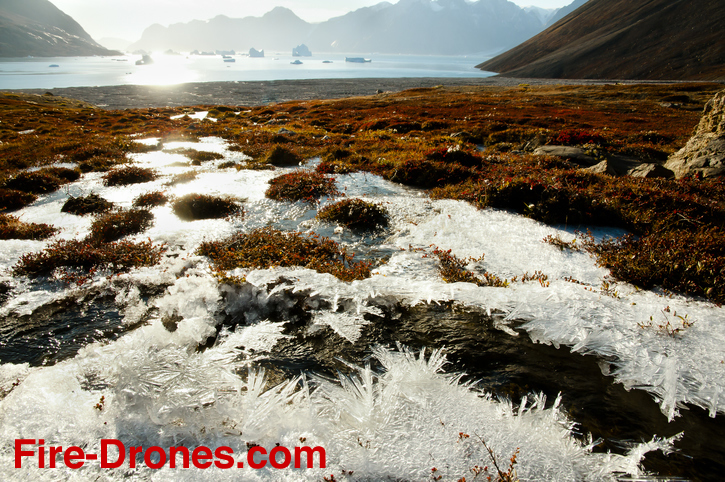
The Arctic Permafrost in Meltdown
The Arctic landscape stores one of the largest natural reservoirs of organic Carbon in the world in its frozen soils. But once thawed, soil microbes in the permafrost can turn that Carbon into the greenhouse gases CO2 and Methane, which enter into the atmosphere and contribute to climate warming." NASA |
|
|
 |
Disruption to
jobs and industries:
Draw up plans to assist
those who will be displaced.
|
Support research
into
the viability of
MegaScale Fire Drones.
|
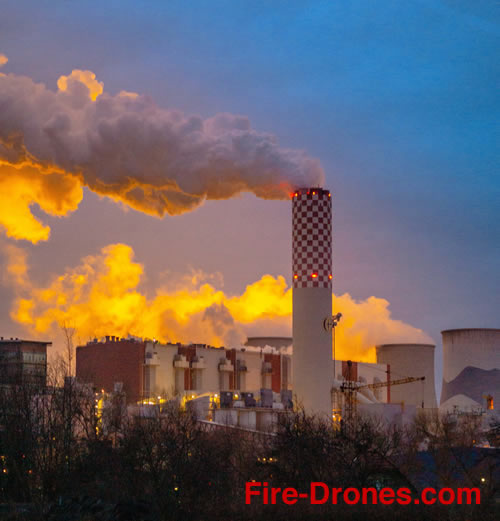
Photo by David Benes on Unsplash
Among the greatest of barriers to turning the planet's energy needs completely green is the livelihoods of individuals and the viability of companies that will be put at risk.
This population represents a significant portion of our friends and neighbors—maybe even you, the reader—and a large swath of business and industry, the home and building heating markets, airlines, large ships, etc.
In order to diffuse this issue, governments need to provide ample support on a wide variety of fronts to those who will be—and regrettably must be—displaced.
Engaging this dynamic is both a necessity, as well as being morally the right thing to do.
It will be very difficult politically to make forward motion with climate amelioration initiatives if we are unwilling to provide generous support and long-term transitional advocacy and assistance to those who currently depend on jobs and industry based on the fossil fuel paradigm.
|

Fire Drones will preserve the natural sequestration of CO2 by forests and tundra, and meaningfully reduce the rate at which Earth's atmosphere is warming.
Fire Drones are a powerful answer to wildfires, tundra and peat fires, and might even be useful in tall-building big city fires.
Fire Drones might be a turning point.
Building out a global 'Fire Drone Armada' to effectively quell all forest and tundra fires in a timely fashion might also be a top priority.
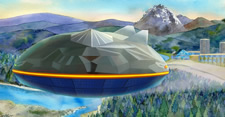 With MegaScale Fire Drone technology brought to scale, and a commitment made to its constant improvement, initial investment and ongoing costs will be well-justified. Gratitude will replace financial concerns. With MegaScale Fire Drone technology brought to scale, and a commitment made to its constant improvement, initial investment and ongoing costs will be well-justified. Gratitude will replace financial concerns.
Regarding Climate Change caused by forest, prairie and tundra wildfires, Fire Drones are a dynamic solution worthy of investigation. |
|
|
|
Cows may soon no longer burp Methane.
Cows and other livestock emit substantial amounts of Methane. A new vaccine administered to the animals shows promise in altering that dynamic.
"AgResearch’s aim is to develop this vaccine, along with other anti-Methane methods, in an effort to allow us to continue eating meat and dairy products while lessening the impact the livestock industry has on the environment. Beef without blame, you might say; and cheese with a clear conscience." BBC |
|
 These Holstein heifers
These Holstein heifers
emit zero Methane. |
|
|
|
Costa Rica: A Model for Nations Everywhere
"In the 1940s, 75% of Costa Rica was covered in rainforests. Following the arrival of loggers, much of the land was cleared to grow crops and livestock. It is unclear just how much land was lost, but  it is thought that between a half and a third of forest cover was destroyed by 1987. it is thought that between a half and a third of forest cover was destroyed by 1987.
Following this devastation, the government intervened to restore and preserve the forests. In 1996, the Costa Rican government made it illegal to chop down forest without approval from authorities and the following year it introduced the Payments for Environmental Services (PES) Program.
Today, close to 60% of the land is once again forest and the landscape is home to around half a million plant and animal species.
The country’s environment minister explains that despite the fact that Costa Rica’s strategy in reforestation and encouraging environmentally friendly behaviour can be applied anywhere, ‘principle and values’ are required, too. He noted that ‘good governance, strong democracy, a respect for human rights and a solid education system’ is vital for success. Madrigal-Cordero added that the secret to Costa Rica’s environmental triumph is a generation of peace. She says, 'nature is in our DNA.' " Read the full story here - EARTH.ORG |
|
|
|
 "Pathway to critical and formidable goal of net-zero emissions by 2050 is narrow but brings huge benefits, according to IEA special report." "Pathway to critical and formidable goal of net-zero emissions by 2050 is narrow but brings huge benefits, according to IEA special report."
May 18th, 2021
"The world’s first comprehensive energy roadmap shows government actions to rapidly boost clean energy and reduce fossil fuel use can create millions of jobs, lift economic growth and keep net zero in reach."
"The world has a viable pathway to building a global energy sector with
net-zero emissions in 2050, but it is narrow and requires an unprecedented transformation of how energy is produced, transported and used globally."
IEA = International Energy Agency • A landmark special report. • Click here to read the full IEA report. IEA |
|
|

"The Intergovernmental Panel on Climate Change (IPCC), a consortium of more than 200 top scientists from around the world, has released its latest report analyzing the latest climate science and findings.
The science is unequivocal: extraction, transportation and burning of fossil fuels is fueling the rise in global emissions, putting us on a path towards planetary destruction and societal collapse."
QUOTE BY GREENPEACE • THE FULL IPCC REPORT HERE • 2021
"...the report also found that changes are happening more quickly now than even in the much more recent past. The rate of sea level rise has roughly doubled since 2006. Each of the past four decades have been successively warmer than the previous one.
Heat waves on land have become significantly hotter since 1950 and marine heat waves — bursts of extreme heat in the ocean that can kill marine life — have doubled in frequency in the past four decades." HENRY FOUNTAIN - NY TIMES |
|
|
Do you have questions about
what's
being presented here?
Do you have suggestions for improving the climate amelioration possibilities showcased?
Click on Questions & Suggestions > |
|
|
|
|
|
|
|

Please consider sharing this website with all those in your circle
whom you feel may be interested or might gain value from.
|
|
|
|
|
|
|
|
|
|
|
 |